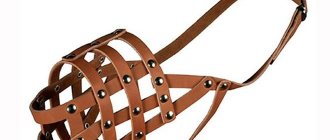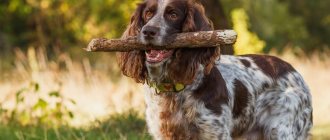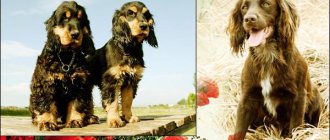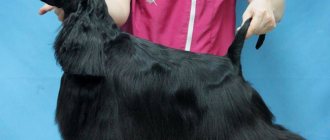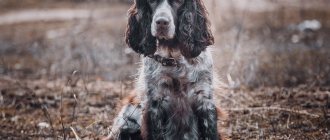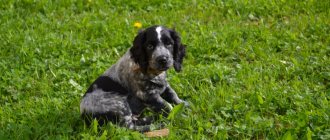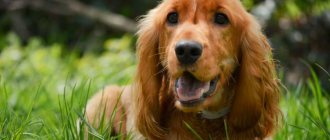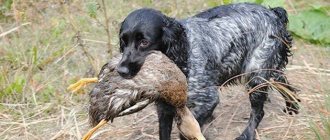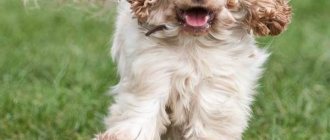| Origin: | Soviet Russia, 1951 |
| Usage: | for hunting wild birds and hare |
| Color: | solid, piebald, spotted |
| Dimensions: | height - 36-44 cm; weight – 13-20 kg |
| Lifespan: | 12 years |
The Russian hunting spaniel is a breed belonging to the gundog type. To date, this is the only variety of the mentioned type that has been obtained through well-organized selection in Russia. For some reason, the standard has not yet been adopted by the FCI, but we have it defined, and the breed has received the right to exist since 1951. Reviews about the Russian hunting spaniel are positive. Owners note high intelligence and extraordinary natural abilities to detect game. The English cocker and springer spaniel were actively used in breeding.
Description of the Russian hunting spaniel breed
Popularity 114th place among 263 dog breeds
Lifespan:
12-14 years old
Breed group:
Hunting
Height:
males: 38-44 cm, females: 36-42 cm
Country of origin:
USSR
Average price:
from 15 thousand rubles
Weight:
13-16 kg
Latest articles Cat health
Rabies vaccination for cats: choice of vaccine, necessity, schedule 01/22/2022 4 0 0
Selection and adaptation
TOP 20 best cat breeds for families with children 01/22/2022 25 0 0
Price
Buying a spaniel is not easy. Advertisements can be found on the Internet, on special boards on city streets, and even on lampposts. But such a purchase is sometimes risky if you want to acquire a purebred “specimen.” The best way out is to contact a nursery.
Then the chosen baby will be healthy and with all the necessary documents. Although, if your goal is not to participate in exhibitions, acquire a hunting companion, or make money from mating, it is quite possible to adopt a puppy from the author of a private ad. But before that, it’s good to look at it and get as much information and all the necessary documents from the seller as possible.
The price of a Russian Cocker Spaniel depends on the place where it is bought. A private owner can sell a puppy for fifty to one hundred dollars. A “premium class” baby from a nursery with a solid reputation will cost about six hundred, but there are also much more expensive ones, far over a thousand. On average, a purebred little friend can cost in the range of three hundred to four hundred dollars.
Advantages and disadvantages
- Pros:
- smart, brave, loyal, obedient;
- gets along well with children and other pets;
- not aggressive and not vindictive, rarely shows anger;
- can be kept in a house or small apartment;
- has excellent hunting abilities and a keen sense of smell.
- Minuses:
- overly energetic and active, therefore needs long and frequent walks;
- susceptible to obesity and food allergies;
- requires special care for the coat and ears, and often suffers from otitis media.
Reviews
Larisa: “Positive, kind, balanced dog. Calm and gentle, I don’t have to worry if my daughters play with her alone. Thanks to the Russian spaniel, we began to go out for walks together more often, and take family trips outside the city into nature. What pleases me most is that, in principle, he is short-haired, and there are no clumps of fur scattered around the house. We don’t use Jack as a hunter, but his qualities are already noticeable, at home his prey is balls and toys.”
Natalya: “My son bought himself a puppy of this breed, not taking into account the fact that he is very active. Unfortunately, due to work, my son cannot walk the dog, as a result of which the little one has already scratched the wallpaper, chewed the furniture, and ruined the flooring in the hallway. My advice is that before buying a dog of this breed, you should think about whether you will be able to devote as much time to it as you need.”
Sergey: “I took this particular breed specifically. I sometimes hunt, mainly partridges and pheasants, so I chose the Russian spaniel as one of my gun dogs. I have never had such a great helper, I regret that I didn’t get a dog earlier. It didn’t take long to teach the necessary commands; while hunting he acts clearly, competently, and calmly. Quickly and effortlessly finds a shot pheasant in the bush. Once we were hunting a bird with Chara, she dived so quickly and caught a wounded duck from a pond that I stood rooted to the spot and couldn’t stop admiring my girl.”
Key facts
The Russian Spaniel is an energetic, lively, inquisitive, optimistic and friendly pet. Nature has endowed the dog with excellent sense of smell and amazing endurance, which allows it to quickly and easily find birds in marshy or dry areas.
The spaniel is an incredibly smart, loyal and obedient dog that is strongly attached to its owner. He gets along well with small children, cats, dogs, and other pets. Such a pet will be an ideal companion for an active family and is definitely not suitable for elderly and constantly busy people.
Description of the Russian Hunting Spaniel breed includes:
- high level of intelligence;
- friendliness, sociability;
- well developed hunting qualities;
- easy training and education;
- rapid adaptation to a new environment;
- unpretentiousness in everyday maintenance, nutrition, care.
If the spaniel is considered in the role of a hunter, it is worth noting such qualities as: perseverance, activity, endurance and complete obedience. The pet swims well in water, dives, and follows all the owner’s commands if it is raised correctly.
The characteristics of the Russian hunting spaniel breed emphasize that this hunting dog is hardy, energetic, patient, persistent and at the same time attached to the owner and his family.
With proper maintenance and proper nutrition, the life expectancy of the Russian Hunting Spaniel is 9-11 years. For a hunting dog this is a normal period. Long-livers occur, but not so often.
The spaniel tolerates cold well, which makes it possible to keep it in the enclosure of a private house. In the winter season, the owner needs to take care of insulating the booth, since without the proper conditions the dog can get sick.
Cupping
There is no clear point of view regarding this topic. Previously, this procedure was considered mandatory, because the dog could damage its tail while hunting. But, over time, the breed began to be purchased more often as pets or for participation in exhibitions.
In this regard, there is no longer any urgent need to dock dogs' tails, because at home or at an exhibition the chances of damaging them are low. If, after all, the purpose of purchasing a Russian Spaniel puppy is to help in hunting, then it is advisable to dock its tail in the first 2 days of life.
During this period, the operation is as painless as possible, the baby loses a little blood, because at the age of several days the blood flow in the tail of dogs has not yet had time to develop as it should.
Older puppies are given local anesthesia during the procedure, and at the end the wound is sutured and bandaged. As a rule, the tail is cut by half or 3/5 of the length.
History of the origin of the Russian hunting spaniel
The animal appeared on the territory of the Russian Federation during the reign of Nikolai Romanov. He was an avid dog breeder and brought various breeds of hunting and guard dogs from abroad. The result of crossing the Italian spinone and the long-haired pointer was the birth of the Russian spaniel, which, at the instigation of the tsar, acquired practical value among domestic dog breeders.
The animals were quickly discovered to have remarkable hunting qualities and the ability to work with game and birds on land and water. In particular, they were often used in catching pheasants, a favorite dish of the imperial family. For this reason, breeding hunting breeds has become a profitable and respected business.
English dog breeders were also involved in selection: they mixed spaniels from the royal nurseries with cocker spaniels. The result was offspring that had some external similarity with their Russian relatives and had similar working qualities.
By the middle of the 20th century, through repeated crossing, breeders developed two breeds of spaniels with significant distinctive features, which are exhibited separately at breeding shows. At the same time, the unofficial English and Russian groups split.
The four-legged representatives of the “castes” differ in appearance and principle of operation, which became the reason for the subsequent mixing of both species. Subsequently, Leningrad cynologists were engaged in breeding spaniels, who bred domestic and imported dogs from abroad, significantly improving the hunting breed.
However, all their achievements were destroyed by the blockade of Leningrad during the Second World War, which is why, after the victory over the Nazis, the number of dogs had to be restored almost from scratch.
In 1950, Soviet cynologists determined the phenotype of the hunting breed and registered the standard for the appearance of the spaniel. Since 1971, mating Russian hunting dogs with other breeds of spaniels was officially prohibited, and this made the breed independent.
In the early 60s of the last century, dogs became very popular among Soviet hunters. Smart, loyal, obedient pets were and remain easy to transport; they take root well in small apartments.
At the moment, the animal population numbers more than 60 thousand individuals; the main breeding centers of the breed remain: Moscow, St. Petersburg, Yekaterinburg, Saratov, Samara. To improve knowledge about the hunting breed in America, the Spaniel Club was opened in 2000, where spaniel owners can register their four-legged friends.
Features of hunting
Representatives of the breed are purposeful and obedient, able to follow the commands of any person with a weapon who happens to be nearby during the hunt.
The tasks of an assistance dog are:
- smell prey;
- scare;
- upon command, bring wounded or killed game to the owner.
While searching, the spaniel moves quickly and easily. A well-trained dog independently determines the method (top or trail) of how to quickly find the victim, depending on the direction of the wind and the surrounding area.
The main feature of the spaniel is its ability to be in continuous contact with its owner and periodically pay attention to him. And in areas with predominant high vegetation, the dog jumps out to smell the owner in the upper air currents and determine his location.
She tells the owner where the prey is when she manages to smell it. At the very moment of the shot, the four-legged assistant stands motionless, and then looks for the shot game and brings it to the owner with a light grip.
Appearance of Russian hunting spaniels
General impression
In life and in the photo, the Russian hunting spaniel is a strong, muscular dog of an elongated format. At the withers it is taller than English Cocker Spaniels, but smaller than the Springer.
Since Soviet breeders paid main attention to endurance, courage, and search characteristics, the eared animal looks a little primitive. Of course, he is far from the glamorous Americans, but he is not without restraint in grace and lightness of charm.
Head
Oval in shape, elongated, wide, with a well-defined skull, the head of the Russian Hunting Spaniel is quite large, while it tapers towards the nose. The forehead is convex, the arches above the eyebrows are well developed. The line of the muzzle is parallel to the line of the forehead. The transition between them is noticeably pronounced.
If you look at the head from the side, you can see that the upper lip is shaped like a rectangle with slightly rounded corners. The lips and nose are black or light brown.
Neck
Moderately long, well developed muscles.
Torso
Sturdy and slightly elongated. The topline is sloping, the back is wide, the loin is short, smoothly turning into a sloping croup. The chest bone is wide, the pelvis is taut.
Front and hind limbs
The front legs are straight, bony and parallel. Elbows set back. The forearms are straight, the pasterns are voluminous, slightly inclined. The length of the legs is ½ the height of the animal at the withers.
The hind limbs are straight and spaced slightly wider than the front ones. The spaniel has short shins and voluminous, straight-set metatarsals. The paws are rounded and arched, the toes are pressed tightly against one another, separated only by long hairs.
Tail
Mobile, thickened at the base. It decreases by half after birth and is located along the line of the back when walking.
Movements
Free, energetic. Animals move well both on land and in water.
Wool
The coat is elongated and noticeably wavy. The guard hair is shiny and adheres well to the animal's body. The head and all limbs are covered with a short and dense coat.
There are longer hairs on the back, croup, sides, and top of the neck. The chest, lower neck, groin and back of the paws are covered with abundant hair, forming dewlaps.
Colors of the Russian Hunting Spaniel
The breed is characterized by 3 types of colors: uniform, 2- and 3-color. Animals with solid colors are dark red, brown, black, and white markings on the throat or sternum are acceptable.
Two-tone spaniels combine similar colors, but they are broken up with distinct light spots. Tricolor - black and white, brown pets with a slight tan. The color may contain inclusions that do not match the main tone of the coat.
Russian hunting spaniel size
The height of the Russian Hunting Spaniel at the withers for males reaches 39-45 centimeters, for females – 35-40 centimeters. The weight of a Russian hunting spaniel in adulthood does not exceed 22 kilograms.
Kinds
One type of breed has been standardized, but in Russia there are crossbreeds. A purebred Russian spaniel can be:
- Plain. Acceptable colors: black, brown, red.
- Two-color: black and white, red-brown, white and red, brown and piebald.
- Tricolor: black, red and white.
- Tan.
Other color options for such a dog are unacceptable according to the standard. The rarest color is pure brown. These dogs are valued much higher and are sold quite expensively. Breeders find clients for such individuals in almost a matter of days.
Character of the Russian hunting spaniel
The Russian spaniel is a wonderful hunter, but in the house the dog becomes a devoted, reliable friend and companion for all family members. He quickly becomes attached to a person and tries to accompany him everywhere.
The dog loves to swim, play and frolic. If the animal is kept in a country house, it must be allowed to run freely around the site or a large fenced space.
The spaniel gets along well with small children and happily gives them all his free time. He runs, jumps, plays, and carries out all the orders of his little masters. You can leave your pet unattended with your child, as the spaniel is very friendly and would never cause any harm to his young friend.
The spaniel treats other pets in the home with patience, but he certainly won’t show the same respect to other people’s cats and will definitely kick them out of the entrusted territory. The dog does not get along with guinea pigs, hamsters, birds - the hunting instinct takes over over time, and small animals die.
In general, this is an intelligent, hardy, strong, active pet with a remarkably developed instinct of a born hunter. The character of the Russian hunting spaniel is peace-loving, loyal, accommodating, he is easy to train, loves unrequitedly and completely obeys a person.
Nutrition
Dogs are “eternally hungry animals” - this popular expression very accurately describes the Russian Spaniel breed. But the diet should be rich in vitamins and minerals necessary for the development of a healthy dog.
Especially at a younger age, as puppies grow and need proper nutrition. If the new owner does not have enough time to prepare food, you can use ready-made food.
The owner’s primary task is to carefully monitor the volume of portions and their relationship with the dog’s physical activity. Otherwise, it will lead to obesity and its negative consequences.
Puppies of this breed should have 4-5 meals a day, with a time interval of at least 3 hours. You need to gradually accustom your dog to feeding twice a day (morning and evening).
Clean water must be constantly available to the animal. It is also important to keep an eye on the bowls and regularly pour boiling water over them.
Expert opinion
Anna Abramenko
An avid dog lover. Experience in veterinary medicine since 2009.
Ask a Question
The list of foods that dogs of this breed should not eat: river fish, seasonings and spices, fatty or smoked meat, fresh baked goods, sweets, legumes.
Authorized products:
- vegetables and fruits in season;
- ground bones;
- dried (stale) bread;
- lungs or stomach;
- intestine cuttings;
- legs, wings;
- sea fish without bones;
- rice, oatmeal or buckwheat cereals;
- cartilage;
- beef, rabbit, turkey or chicken meat;
- kidneys, heart, liver;
- kefir, low-fat cottage cheese, milk.
It is important to cook the intestines or stomach well so that the dog does not contract gastrointestinal infections. Before eating, it is enough to scald the meat, twist it into minced meat for very small puppies, and for 7-8 month olds it can be cut into small pieces.
Expert opinion
Anna Abramenko
An avid dog lover. Experience in veterinary medicine since 2009.
Ask a Question
It is advisable that the dog eats its entire portion, but if this does not happen, then the remaining food must be removed and the portion size reduced for subsequent feedings.
Spaniel hunters are given boiled waste from the hunt, so that later, when catching, the dogs do not tear the game.
Education and training
As a rule, spaniel puppies acquire their own home and owner by 3 months of age. In the first days, the owner needs to show the baby as much attention, care and patience as possible, realizing that parting with the mother was not easy.
The puppy quickly gets acquainted with the new living conditions, its inhabitants and ceases to be afraid of extraneous sounds. Already at this time, the owner needs to start disciplining the pet - without shouting or physical punishment, teach it standard commands.
It is important to realize that a hunting dog must grow up obedient, it must have one owner with unquestionable authority. For this reason, one person takes part in training a pet, and not the whole family. It is unacceptable when someone forbids something to a dog, while another, on the contrary, allows and encourages it.
From the very beginning, the dog needs to be given a place to eat and sleep. You should not allow her to sleep on her owners’ bed or eat human food from the table. It is almost impossible to re-educate a pet after bad habits have formed.
Raising and training a Russian hunting spaniel is a labor-intensive, but very interesting task. The animal grasps everything new on the fly and completely obeys its owner. When training, it is important to use several methods that force the spaniel to remember commands:
- incentive
– when the desired action is encouraged by a treat;
- mechanical
– in studies, force is used (for example, pressing on the body, but in no case a blow);
- contrasting
– the two previous methods are combined;
- imitative
– an inexperienced dog copies the actions of a trained dog.
After mastering the training course, the spaniel will follow orders without the use of force or treats. The dog must be praised for every excellent result. Excessive punishment for disobedience is unacceptable, otherwise there is a high risk of completely losing contact with the pet.
Physical punishment can be light pressure on the dog’s back, a gentle blow to the rump with a wooden rod with a dissatisfied intonation in the voice.
Commands must be pronounced in a confident tone, loud and clear. It is impossible to replace them with orders that are similar in meaning, otherwise the animal will become confused, and the learning process will become significantly more complicated and extended over time.
Looking for a Russian Hunting Spaniel? Find your pet from 2 offers As a gift
Key points in training
A Spaniel puppy chooses one owner to obey. But for this, a person needs to show his leadership qualities and show the dog the existing hierarchy in the family.
In order for your pet to understand that the people in the house are the main ones, you need to teach him some habits:
- Feeding is carried out only after the whole family has eaten;
- You can enter the room only after everyone has entered;
- Walking, sleeping, and playing on human furniture is strictly prohibited.
Representatives of the breed tend to dominate. All attempts to dominate or show character must be stopped. However, crude methods will not work. Enough with a stern look, a firm word, and deprivation of treats.
The owner needs to learn not to react to begging, puppy dog eyes, and acting techniques.
Raising a dog begins from the first days of life, but training begins from 3-4 months , when the puppy remembers its name. You can contact the kennel club and take the “Dog in the City” course. It will help the dog socialize and the owner to establish contact with the animal.
For a hunting dog, it is important to unquestioningly follow basic commands:
- "Near";
- "To me";
- "It is forbidden";
- "Sit";
- "Voice".
Read about how to properly train a dog in the article: “Training a puppy: effective methods from dog handlers, learning commands at home.”
If the owner has not achieved obedience, the pet is unlikely to become a good helper. To train individual hunting skills, it is worth contacting specially trained people.
Health and diseases of the Russian hunting spaniel
The general condition of the pet is determined by living conditions, nutrition, and the efforts of the breeder. Your spaniel should be taken to the veterinarian 2-4 times a year for tests and a general examination to identify health problems at an early stage of development.
Possible diseases
The hunting breed is predisposed to the following diseases:
- Obesity
– the reasons are unbalanced nutrition, lack of exercise and violation of the regime.
- Food allergies
– new foods should be introduced into the dog’s daily diet carefully, and if an adverse reaction from the body is detected, they should be immediately excluded.
- Otitis
– inflammation of the ear from the inside or outside.
- Blockage of the paraanal glands
– if the problem becomes chronic, then they resort to surgical intervention and their removal. All early stages are treated with medication.
- Mycosis
– the disease is provoked by parasitic fungi that affect internal organs and skin.
- Leptospirosis
– a bacterial infection affects the kidneys.
To prevent most diseases, your dog needs to have all routine vaccinations on time. Regular treatment of the animal with drugs against internal and external parasites is also required.
Reproductive health
In the Russian Spaniel, sexual maturity occurs at 9 months of age, but the first mating is not recommended before 1 year. Pregnancy lasts 55-73 days, but most bitches give birth 59-60 days after mating.
If you do not plan to breed the Russian Spaniel breed, it is better to castrate or sterilize the dog. After the operation, the animals will lose the ability to reproduce and become much calmer.
Colors
There are 3 types of breed depending on color:
- Spotted - on a light gray, white background, large or small marks are visible throughout the body. The more precise name of the color is determined by their shade. This type can be found in two versions:
- speckled (small frequent marks);
- contrasting (clearly defined spots).
Expert opinion
Anna Abramenko
An avid dog lover. Experience in veterinary medicine since 2009.
Ask a Question
As dogs of the second color develop with age, they develop small markings and become difficult to distinguish from mottled dogs.
- Plain - sometimes with white markings on the limbs, throat, belly and on the forehead, chest, muzzle and tip of the tail (for example, black and white - light on a dark background).
- Tan marks are red markings on certain parts of the dog’s body: paws, ears, under the tail, above the eyes, cheeks and chest. The most popular option is black and red tan.
Color varieties:
- brown - it is very rare to find such a dog.
It has several shades:
- coffee;
- hepatic;
- chocolate.
- black is a fairly popular color among the breed;
- red – peculiar, currently uncommon.
Features of feeding and diet
The Russian spaniel has an excellent appetite and is ready to eat food around the clock. To prevent obesity, it is important to correctly calculate the amount of food and take care of a sufficient amount of physical activity.
So, for an adult animal leading an active lifestyle, 250 grams of dry food per day is enough. If natural food is given, its quantity should not exceed 60 grams per 1 kilogram of the dog’s weight. An increase in the norm is only possible for pets recovering from illness, nursing bitches and animals that live in an enclosure.
Three times a month, the Russian Spaniel requires unloading. On such days he should receive half as much food. The dog's diet should include beef - it is given several times a week, raw or boiled. It is better to take away a bird caught during a hunt so that the spaniel does not develop the habit of dealing with birds on its own and not bringing it to the owner.
Otherwise, the animal is fed in the same way as other hunting dogs - boiled sea fish 3-4 times a month, low-fat fermented milk products 2 times a week, cereal porridge boiled in water or broth every day.
The animal should be given vegetables, fruits, greens, boiled or raw. Sometimes you can add a chicken egg to your diet in the form of an omelet or mixed with dairy products.
Spaniels also love rye crackers, which owners often use as a reward for correctly executed commands during training. Dried fruits should be given in exceptional cases: the dog must understand that this is a “delicacy” and must be earned.
Mating
Dogs can be untied at the age of 20-25 months, although puberty comes much earlier (8-10 months). It is during this period that the female will go into her third heat, and a loose loop and light discharge will be a signal that the girl is ready.
To officially transport the breeding, owners need to fill out certificates and forms at the nursery. The male is selected in advance, the owners agree on the date and price, which is usually equal to one puppy or a percentage of its cost.
Pets must be checked for pathologies and diseases and undergo deworming 2 weeks before mating.
Spaniels are not large, they do not need much space. The pets are introduced, walked together, and brought to the dog’s territory. Here the boy will feel relaxed and free. If the female is calm and everything suits her, then the male will be able to make a cage. Otherwise, you need to give the dogs more time or try another day.
Sexual intercourse lasts from 10 to 15 minutes , during which time the animals are helped not to lose their balance: the girl is held under the stomach and by the head, the boy is guided into a noose. You can invite a specially trained person. In the absence of a lock, the female can be fertilized. The fixative mating is carried out after 2 days .
Read a detailed article on the topic: “Everything you need to know about breeding dogs: appropriate age, what to do if it doesn’t work out, rules and tips.”
Care and maintenance
A spaniel can be kept in a house or apartment, provided it is given frequent and long walks outside. The puppy needs to immediately be allocated a place in the home: it should be secluded, protected from heat and drafts. It is important to protect a hunting dog from strong foreign odors, which can negatively affect the pet’s sense of smell.
The dog's sleeping place should be clean, with a water bowl and food bowl freely available. The dog should have favorite toys, a leash, a collar, a hair brush and hygiene products. A spaniel does not require clothing: its thick coat can protect it even in severe frosts.
An active and energetic animal requires regular and frequent walks lasting at least an hour. The spaniel loves to jump, run and play; in urban areas there are special areas for this. Periodic trips to a field or forest would be appropriate, where the animal can run around without a muzzle or leash, or swim in a pond.
The difficulty in caring for and maintaining the Russian hunting spaniel is the coat, which quickly becomes dirty and forms tangles. But if you accustom the animal to the procedure of bathing, combing and cutting from an early age, then no special problems will arise.
Particular attention is paid to the ears. They need to be cleaned several times a week with damp cotton pads, and ventilated once every two weeks by waving them from side to side for several minutes.
Teeth are brushed with a brush and a special paste several times a month. To prevent the formation of tartar, the dog is given special bones, crackers, hard fruits and vegetables.
The claws are trimmed once a month with special scissors or tongs, and the dog sharpens them on the asphalt while walking. If this does not happen, you can polish them with a hard file.
Characteristics and standards
Despite the fact that the dog is sometimes too energetic and temperamental, it is always ready to instantly fulfill any request of its owner, to whom it is infinitely devoted. The breed has an excellent sense of smell, can dive and swim, hunt field, swamp and pine forest game, and find wounded prey using a bloody trail.
It is also capable of working as a guard, although there is an opinion that developing the characteristics of a guard dog can harm its hunting qualities.
The breed is more suitable for people leading a dynamic lifestyle. These dogs need systematic exercise and long walks, otherwise they can become hyperactive. They are highly trainable and calmly accept children and other pets.
Official standard of the Russian hunting spaniel:
- The head is symmetrical to the body, the skull and muzzle correspond to each other in size. The forehead is wide, and the back of the head is slightly voluminous; the transition to the muzzle, although smooth, is noticeable. The lips are located close to the mouth and have pigmentation. The teeth are symmetrical, scissor bite. The nose is large with round nostrils, black or brown. The ears are elongated, pleasant to the touch, small in thickness, and set high.
- The body is sinewy, rectangular in shape. The neck is powerful, the chest has elastic ribs, and the back is wide, flat and muscular from the middle to the tail. Tanned groin line.
- Paws with strong joints, their height is half the height of the dog. The front legs are level, located slightly wider than the chest, and the distance between the hind legs is slightly greater than that of the front legs. Hips with sloping shins, oblong, with strong hocks. The fingers are curled, pressed tightly against each other.
- The tail, in a calm state, is located at the same level with the spine. When excited - a little higher. Its docking to the middle of the length is not a mandatory requirement.
Vices that are grounds for disqualification:
- eyes of different colors;
- cowardice;
- problematic teeth (including malocclusion);
- aggression;
- mild gender difference;
- short tail.
Coat type and color:
- Smooth hair, with fur of medium length, even or with small curls. The entire body is covered with a continuous water-repellent undercoat. On the face and paws the fur is short, on the ears, tail, chest and belly, and on the back of the legs it is long and curly.
- The color of a dog’s coat can be one-color with tan - black, brown, red or without, two-tone - basic white with spots of the same shades as in the first case (additional specks to match the markings are possible). And the last option - consisting of three colors in the same range as the previous ones, only with an additional tan.
Tips for choosing a puppy
It is better to purchase a baby Russian spaniel from official breeders. Here you can get acquainted with the pedigree of the parents, their achievements, diplomas from exhibitions and more.
Before purchasing a puppy, it is recommended to visit the nursery several times and evaluate the living conditions. Be sure to watch how your baby eats. If he has no appetite, it means he has health problems. A healthy dog's bowl always remains empty.
At 2 months of age, the spaniel stands well on its feet, runs quickly, and takes part in what is happening around it with great interest. Choose a Russian Hunting Spaniel puppy with a clearly visible hump on the nose - this is evidence that over time the muzzle will stretch to the desired size. Individuals with straight or snub noses usually grow up with a short muzzle, which is considered a defect.
Among the pack of puppies, it is easy to spot future leaders. Such dogs become excellent hunters and loyal friends. Children are tested for courage by clapping their hands strongly in silence or by turning them over on their backs and holding them in this position for several minutes. Puppies with the makings of a hunter will react calmly to noise, but will perceive physical impact with obvious anger and will try to get back on their feet.
When choosing, another “test” is also appropriate - waving a rag in front of the puppy’s nose. The potential leader will immediately sense the “prey” and will not let it pass, clinging to it with his teeth.
How to choose a puppy
The choice of a puppy depends entirely on the financial capabilities and wishes of the potential owner. You need to decide on the gender of your pet. Males are better suited for hunting, but they are more capricious. Bitches are usually softer and can give birth.
In addition, it is worth choosing the puppy’s class in advance. Not only the dog’s future career depends on it, but also its cost. There are 3 classes that are assigned to an animal a couple of months after birth:
- Pet class - dogs with minor deviations that do not prevent them from becoming good pets;
- Breeding class – animals with ideal external characteristics, fully complying with the standard, suitable for breeding;
- Show class - pets with a good pedigree, born champions and prize-winners, their future career is exhibitions.
A puppy can be purchased at the age of 2.5-3 months. Small dogs are easier to train and adapt to their needs. But there is a lot of trouble with them, including vaccinations and special feeding. Experienced dog breeders prefer to buy older animals (5-6 months), but in this case problems with training may arise.
A good breeder will provide a package of necessary documents, tell you about the litter and parents, and help you decide on your future pet. The kennel has the right not to sell a dog if the potential owner does not meet the criteria or is not suitable to raise the dog .
Puppies will always be playful, perky and active. Healthy dogs must be clean, meet the standard and have no obvious pathologies. The cost depends entirely on the class of the pet: from 3,000 to 20,000 rubles .
Breed care
As a rule, the Russian Spaniel is combed to make it look neat. After each walk, the paws are inspected for debris and splinters. Water treatments are carried out as needed.
The dog also loves to swim in open water.
The eyes are considered a vulnerable spot of the animal, so they must be carefully monitored. The owner periodically checks them for the presence of discharge. If the fluid secreted is abundant, then the dog is taken to a veterinary clinic. The veterinarian will prescribe the appropriate treatment.
When water gets in or due to increased humidity, an inflammatory process occurs in the ear openings. To avoid this, the room is regularly ventilated, and after bathing the ears are secured to the head with rubber bands or clothespins.
Every month, the claws are trimmed using a nail clipper. In addition, the animal is regularly treated for parasites. Teeth are cleaned using a special brush. To remove tartar and plaque, contact a veterinarian.
Story
Black spaniel dogs first appeared in the mid-19th century. At first they were not very popular, but by the beginning of the next century, dog breeders began to actively breed such dogs.
At the same time, by the end of the 19th century, dogs with other colors began to spread.
For example, white and red spaniels or dogs with gray spots were often found. Additional Information ! The dog first received general recognition in 1893, when it was recognized by representatives of the English Kennel Club.
Life expectancy and what diseases are they susceptible to?
Black Russian spaniels live 13-16 years, and dogs of this breed can be susceptible to the following ailments:
- Inflammation of the ears.
- Demodecosis.
- Allergy.
- Obesity.
- Blockage of the anal glands.
CAREFULLY!
A dog used as a gundog may be at increased risk of contracting infectious diseases, including those carried by ticks, which are abundant in forests and fields.
Therefore, the Russian spaniel needs timely vaccinations and preventive treatments against external and internal parasites.

